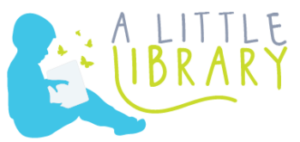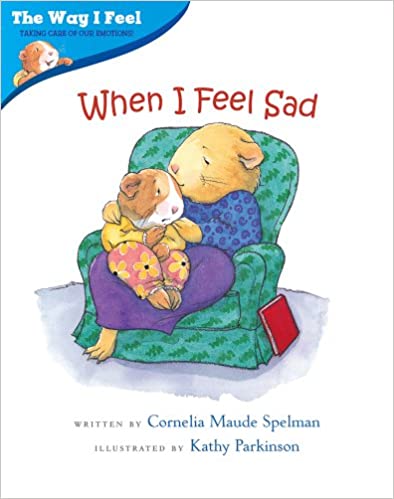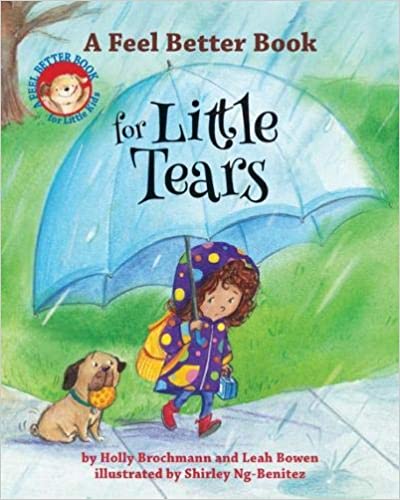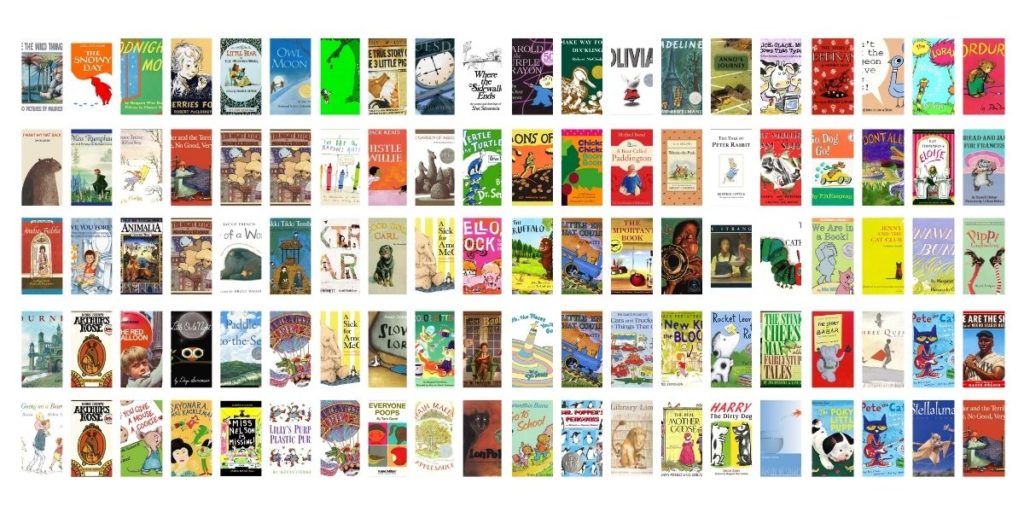My daughter is getting to the age where she can interpret emotions in other people. She is beginning to develop an awareness of feelings and empathy. The other day she hit her daddy by accident and went over to give him a hug. She was able to tell that her actions caused him pain, and that she needed to comfort him. If mommy gets teary she’ll come over and give me a hug. “Mommy, you okay?”
I think she’s still a little young (she’s two and a half now) to fully understand grief and sadness. But what if something sad happens earlier than that? Although I’m hesitant to introduce anything negative or sad into her life I wanted to start putting together a list of books that will help explain this emotion and how to deal with it. Just writing this post made me sad. It hurts that small children need to deal with hard emotions.
But regardless of our desire for sunshine and rainbows, sometimes bad things happen, and it’s important to have resources to help both child and parent understand big emotions. Picture books are a wonderful way to do this. They can help introduce sadness by:
- Giving a label to what the child is feeling
- Explain reasons the child might feel that way
- Express different ways to cope with that feeling
- Explain that feelings are not necessarily good or bad, they just are
- Avoid minimizing feelings
Note: there are some very very sad books out there for kids: books dealing with the death of a parent or grandparent or pet, and some with the loss of their own life. I will leave those lists for a psychologist or specialist to recommend.
Here are some good books that gently touch on the subject of sadness, but that I still feel comfortable sharing with my daughter. These books all acknowledge the emotion of sadness and help children understand that feeling sad or gloomy is natural and okay.
THe Best Books About Sadness for Toddlers
The Rabbit Listened by Cori Doerrfeld. I love this book! It’s about a little boy who is sad because his block tower fell down. One by one all the animals come to give him advice, or tell him how to feel or what to do, but none of them truly offer him comfort. Finally the rabbit comes and just listens to the little boy, which is exactly what the little boy needs.
The act of listening can bring such comfort. As a very pregnant person I very much relate to this. There’s not much you can do about heartburn and a tiny person kicking your ribs, but having someone listen and acknowledge what you’re going through is nice.
Check out the reviews for this book on Amazon, I scrolled through and was impressed by how many teachers and psychologists (and normal folk!) raved about it. The Rabbit Listened is recommended for children ages 3-5 years old (or very pregnant people with toddlers).
When Sadness is At Your Door is the first book in Eva Eland’s Big Emotions series. It’s a picture book that focuses mostly on images to help children understand emotions and how to deal with them in simple words. While letting the child know that feeling sad is okay and normal, it also offers suggestions on how to deal with sadness, such as drawing, or going on a walk, or just sitting quietly together. My favorite part of this book is the way sadness is depicted in the illustrations as a big grey/blue sad lump. This book is recommended for children ages 3-7.
Bob’s Blue Period is a gentle introduction to sadness. It’s about Bob the bird whose friend went away for a while. Bob is sad, so everything he paints is the color blue. He needs his friends to help find his bright colors again. I like this book because of the beautiful watercolors and unique hand written lettering. This book is recommended for children ages 4-7.
The Pout Pout Fish is a New York Times bestseller for children ages 3-6. We read this book when Ava was two and she loved it. The repetitious wording is especially attractive to the younger ones.
“Deep in the water,
Mr. Fish swims about
With his fish face stuck
In a permanent pout.”
Grumpy Pants by Claire Messer is about Penguin who is having a grumpy day and doesn’t know why. He tries everything he can to get rid of his grumpiness and finally realizes he just needs to start afresh by washing the grumpiness away. This is a great book for acknowledging feelings and why or why not we experience them. The publisher recommends this book for children ages 4-8, but my daughter enjoyed reading it at age two.
When I Feel Sad by Cornelia Maude Spelman is part of The Way I Feel book series. The book’s protagonist is a small hedgehog who tells the reader why she sometimes feels sad. The simple reasons given are very relevant and relatable to a toddler and can bring up good discussion points: “Sometimes I feel sad when I get hurt too!”
“I feel sad when someone won’t let me play, or when I really want to tell about something and nobody listens.”
Small Hedgehog – When I Feel Sad
The Saddest King by Chris Wormell takes place in a kingdom where everyone is happy all the time – but only because the king orders it so. One day a little boy shows the king that you don’t have to be happy all the time, and that being sad is normal and okay. This book is recommended for children ages 5-7.
A Feel Better Book for Little Tears by Holly Brochmann and Leah Bowen is part of the Feel Better Books for Little Kids series. The publisher recommends this book for children ages 3-5. The Feel Better Book series helps kids understand what they’re feeling, and that it’s okay and normal to have these feelings. At the end of the book is a lengthy note to parents and caregivers on how to help your child deal with feelings of sadness. This book is a great learning resource for both adults and children.
I hope this list gave you some resources about introducing your toddler to difficult emotions. The books I included are just several of my favorite that have resonated with my daughter, but there are hundreds of great books out there. For more resources on talking to your child about emotions, check out this article from Vanderbilt University called Teaching Your Child to Identify and Express Emotions. It lists four steps how you can help your child effectively and appropriately understand and express their feelings. I hope these books about sadness for toddlers helped you and your little one. Thanks for reading!
The Best Children’s Book Quotes About Love
In this post I’ve gathered my favorite children’s book quotes about love. Valentine’s Day is…
Children’s Book Trends Based on TIME Magazine’s 100 Best Children’s Books
A basic survey of children’s book trends throughout the past century with data based on…
The Best Dr. Seuss Books for Toddlers
Did you know that today, March 2, is Dr. Seuss’s birthday? What better day for…












